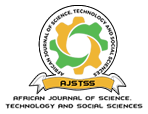The effects of COVID-19 Pandemic on maternal and childhood health services in Meru County, Kenya
DOI:
https://doi.org/10.58506/ajstss.v2i2.142Keywords:
COVID -19, Maternal and Child Health, Animal-human conflict, Wildlife-human interface, Meru National Park., PandemicAbstract
Background: The outbreak of coronavirus put unprecedented burden on healthcare systems, governments and health professionals worldwide. It caused a global crisis of unequalled magnitude on service delivery and accessibility of essential health services. Women and children in poor countries were most affected. In view of the foregoing, it became necessary to examine the effects of COVID -19 outbreak on Maternal Child Health (MCH) in Meru County Kenya, to recommend mitigation strategies and safeguard the gains previously made in MCH indicators.
Methods: Ethical clearance for the study was sought from Meru University of Science and Technology Institute Research Ethics and Review Committee (MIRERC). Data were gathered through focus group discussions, key informant interviews and review of health records in Meru County. A period of one year before and one year after COVID-19 pandemic were compared in the nine sub-counties. Analysis was done using SPSS computer package and statistical tests carried out using 2t test. Descriptive and inferential statistics were employed to summarize the data.
Results: There were no significant changes in the overall BCG coverage (p=.30), FIC (p=.098), proportion of pregnant adolescents 10-19 years (p=.83), pregnant women attending at least one ANC visit (p=.41) and the number of WRA who received FP commodities (p=.66). Nevertheless, the proportion of women with 4th antenatal care visit and adolescents 10 - 14 years pregnant at the first ANC visit had lower and higher mean scores during the pandemic with significant changes at p=.05 of (p=0.011) and (p=0.003) respectively.
Conclusions: COVID- 19 pandemic did not fundamentally affect MCH services during the first year of the sickness in Meru County. However, the proportion of teenage pregnancies increased significantly, while the proportion of women with 4th antenatal care visit decreased.


